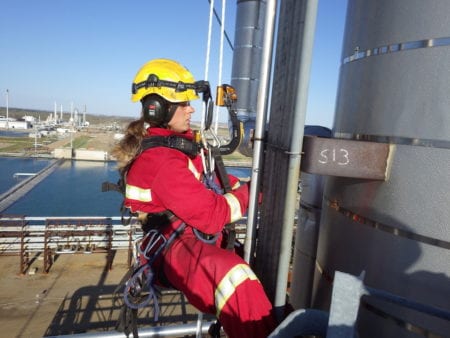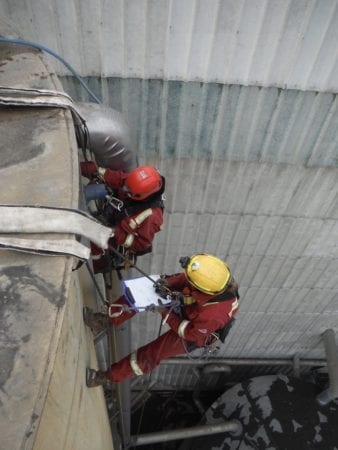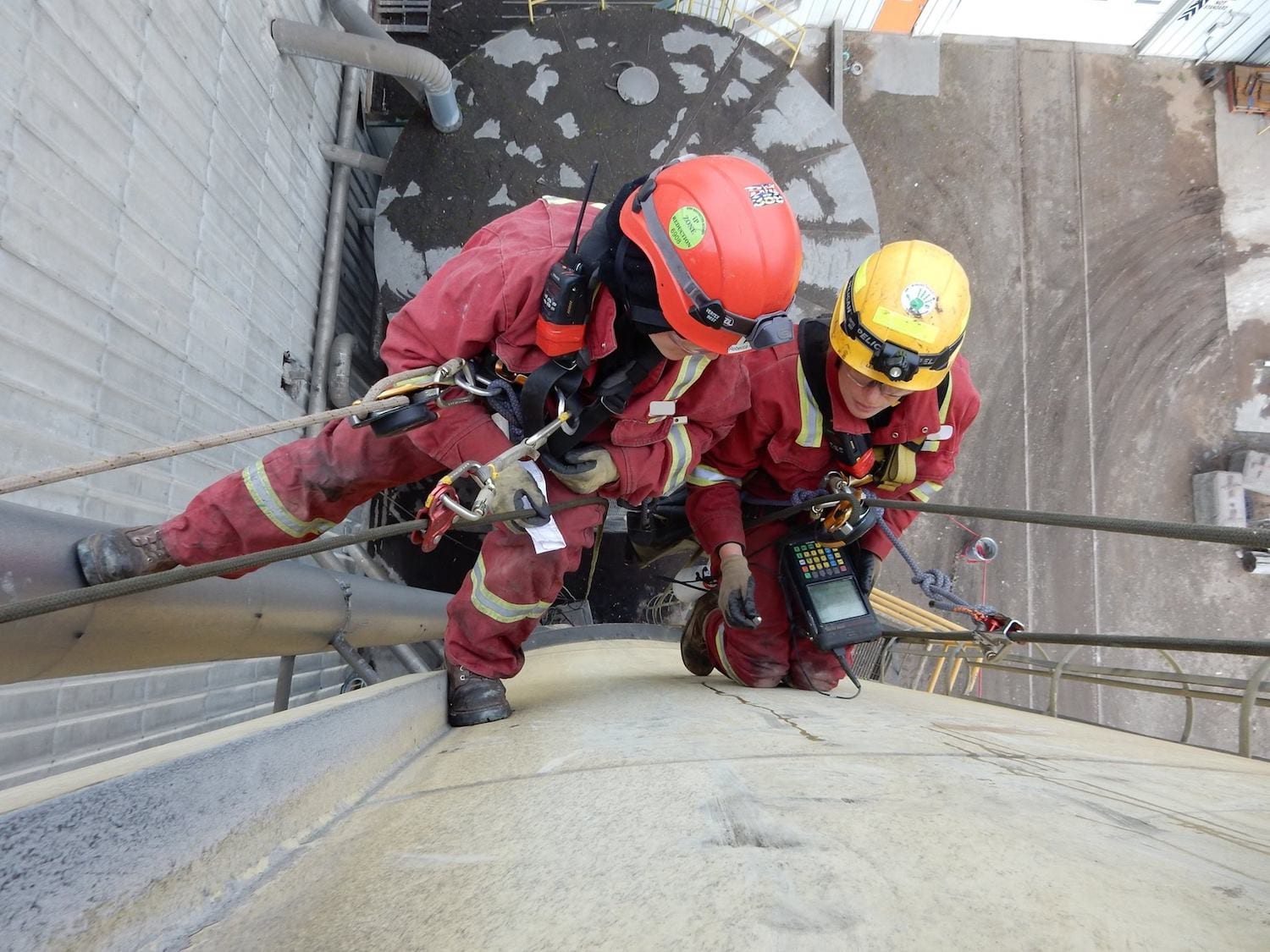Whatever you do, don’t send pictures of Leslie Poulson at work to her mother.
“She doesn’t like to think about it,” says the New Zealand native. “My dad, on the other hand, thinks it’s great.”
Poulson is in rarefied air, literally, in her field. She’s one of the few women who hold a Level 3 certificate from the Industrial Rope Access Trade Association (IRATA), which means she not only can climb the world’s tallest structures, but she can also rescue climbers in trouble.
Based north of Vancouver, British Columbia, Poulson is dispatched to job sites throughout Canada by her employer, Tacten Industrial, to scramble up and down bridges, wind turbines, skyscrapers and other massive structures to perform maintenance from above.
Rope access service work is essential to industries will difficult-to-reach equipment, often suspended high in the air, that needs periodic maintenance and repairs. When, say, a series of large wind turbines need servicing, the power company can shut them down and bring in a contractor to assemble scaffolding to reach a specific area. But the more efficient approach is to bring in a rope access technician to climb up and do the job in less than half the time.
Poulson maintains an online community, Women in Rope Access, for women who work in the industry. It’s a male-dominated industry — of the 9,224 IRATA-trained Level 3 technicians worldwide, 63 are women — but Poulson says it’s also female friendly.
“As long as you can do the job safely, people don’t care who you are.”
Learning ‘The Ropes’
Swinging hundreds of feet above the ground is something Poulson never pictured herself doing.
“I was actually petrified of heights growing up. That continued when I met my boyfriend, who was a rock climber. He’d take me on some small climbs, and I’d cry,” she says. “But gradually I learned to feel safe and comfortable in the air and we’d eventually climb 1,000-foot cliffs together.”
The two moved to Canada where her boyfriend got involved in the rope access industry. That sparked her interest and Poulson started her training about four years ago. “It’s a good group of people who get into rope access. We go through the same issues and experiences at work and we support each other.”
SEE ALSO: For Climbers, Fixing Wind Turbines Is a Labor of Love
Training starts with a Level 1 course, which is supervised and taught by IRATA professionals. It’s a five-day curriculum that focuses on how to maneuver and get around on a structure safely. After 1,000 hours and a year on the job, a trainee can apply for a Level 2 certificate, learning how to rig ropes and also save a stuck co-worker. After another year and 1,000 hours, trainees can reach the Level 3 plateau, where they’re taught complex rigging and management skills, coordinating rope techs so they can complete a job quickly and safely.
“When you’re at Level 3, you’re generally supervising a job,” Poulson says. “It’s your responsibility to make sure everyone’s safe and the job is being done correctly.”
Service Above — Far Above —Terra Firma
 When her services are needed, Poulson gets a call from her manager and then flies to job sites around the country. Projects can stack up on her calendar and then just as quickly she can go a month or two without any jobs. “I like that because it allows me some freedom,” she says. “I can work when I want to, basically.”
When her services are needed, Poulson gets a call from her manager and then flies to job sites around the country. Projects can stack up on her calendar and then just as quickly she can go a month or two without any jobs. “I like that because it allows me some freedom,” she says. “I can work when I want to, basically.”
The rope tech’s gear is basic: overalls, hardhat and steel-toed boots, plus standard climbing gear — harnesses, slings, clamps and carabiners. In addition, there’s usually a radio and tools for the particular job that day.
Pay for rope techs varies, from $10 to $16 (U.S.) per hour for beginners to $55 per hour and up for skilled Level 3 techs. There’s also a particular need for tradespeople with specialized skills who can handle heights.
“If you’re a welder or mechanic who is qualified on ropes you can almost name your price,” says Poulson. “But there aren’t many of those people.”
Poulson has seen many tradespeople try to get their rope certification and fail.
“It’s not for everyone. You’ve got to be in shape to maneuver yourself into position and be able to weld or make a repair when you can’t use your feet on the ground to stabilize you, which is hard. Another critical point is you have to work without dropping a tool, which can kill someone hundreds of feet below.”
There’s also the weather. When sustained winds get beyond 20mph, rope work is generally stopped, as it is when lightning is reported within 60 miles of the job site. But heavy rain? Snow? Blistering heat? Rope techs have to work through it all, and there’s no extra pay for bad weather.
Although one would think the job is filled with daredevils, and it does attract them, people with that personality often wash out.
“At a job site the first priority is safety and when you as a supervisor see someone taking unnecessary risks while on the ropes, you call them out on it,” she says. “If you’re not being safe, you’re risking the lives of your co-workers and you stop getting called for jobs. It’s a small industry and people talk.”
When she’s not at work, it’s a good bet that Poulson is planning her next recreational climb among the Canadian Rockies.
“People will ask why I like rock climbing for fun since I climb for work. The difference is when you’re climbing a structure it’s very controlled and there are usually few surprises. You know what it’s going to be like. With rocks and cliffs you’ve got to figure out how to get to your next spot, and you’re not scrubbing grease off of a tower, so it’s fun.”
Images via Leslie Poulson


Using safety equipment certainly makes the job a lot more comfortable. Even just 50 feet up my radio tower is very tense until I get the safety belt clamped in place. As for a dropped tool hazard, there is in many places a rule about nobody below with workers above, for that exact reason.